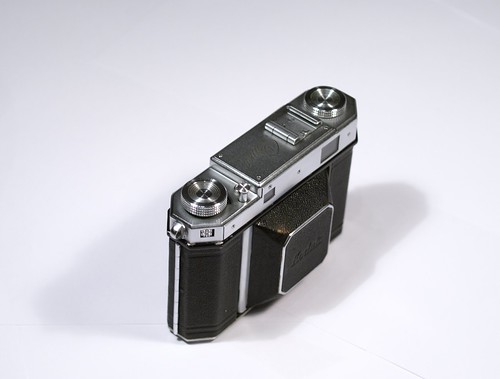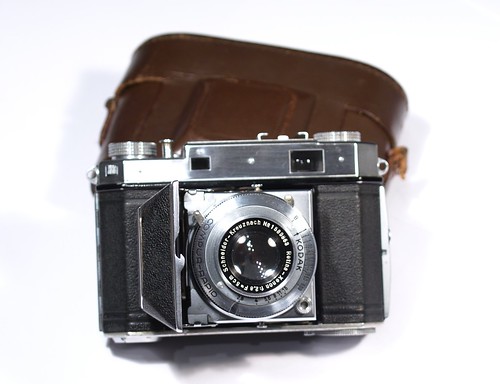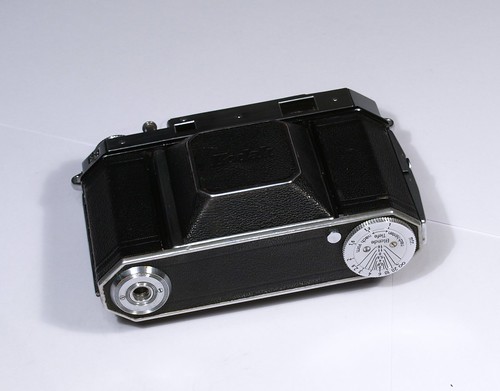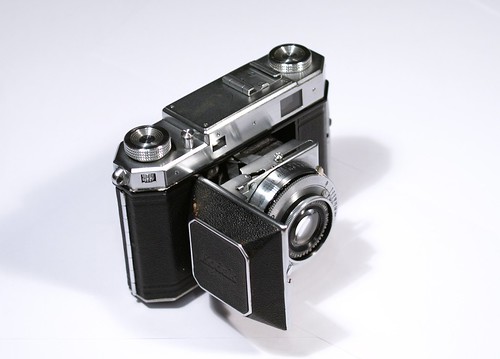- Type 150
- Serial No: 362056K
- Manufactured: 1939-1941 (yes, right)
- Manufacturer: Kodak
- Shutter: Compur-Rapid
- Shutter No: 6059689
- Speeds: 1, 1/2, 1/5, 1/10, 1/25, 1/50, 1/100, 1/250, 1/500 and B
- Lens: Schneider-Kreuznach - Retina-Xenon f:2.8 F=5cm (uncoated)
- Aperture: between 2.8 and 16 without stops
- Lens No: 1589863
- Lens mount: fixed
- Last CLA: unknown

The two visual differences you can use to identify it are that this one has film wind knob while the later types have a lever and this one has a depth-of-field scale wheel at the bottom which is missing from the 1951-54 series.
The camera itself is small. It fits in a larger pocket when folded. It’s surprisingly heavy and robust for the small size, feels like something very serious and extremely reliable - and it is. It can provide you with a sufficient range of shutter speeds to 1/500 and an acceptable choice of apertures.

It’s a really old camera, not something from the 50’s so it’s a little bit difficult to use. You have to turn the camera to yourself to be able to set the aperture and shutter speed, for example. Accidentally modifying the settings is easy so be careful and check them before each shot. Your finger can unintentionally turn the shutter speed ring when you cock the shutter.
The rangefinder is coupled and surprisingly usable; a pink spot picture on the blueish image of the viewfinder. In fact it’s far better than the rangefinder of a Super Dollina II or an early Zorki or Fed.

You can find a depth-of-field scale wheel typically Nagel on the bottom of the camera. It can be used to pre-calculate the right distance setting when one decides to go with zone focusing instead of using the rangefinder. Zone focusing is like anything else with this camera: possible but not easy.

The Kodak Retina IIa is a beautiful camera. No doubt about it. The Type 150 is even more. It’s usable but it’s so old that you have to make some compromises despite the good range of f stops and shutter speeds. (I’m willing to make compromises and hardly waiting to put a black & white film into it and go out somewhere.)

There is no coating on the lenses so it’s better to be careful with the light sources. On top of that, the lens is meant to render black and white images. Using a color film it can produce really strange colors. The result is completely unpredictable, sometimes too red, sometimes too blue, sometimes too orange, sometimes dead grey and sometimes ok.
Here are some test shots with more or less realistic colors (a bit yellowish, but just a bit):



Do you want some extra attention for yourself? Get a Retina IIa, put a roll of 35mm film into it and go to take some pictures. This camera is not an ordinary view, especially not in action.
I couldn’t find any manual for this exact type so I had to experiment with it for a while to get to know each other and I found two quirks:
- There is an interlock which prohibits the camera to fold when the focus ring is not set to infinity. It looks like the folding unlock buttons to be jammed, but if you set the focus to infinity, everything works fine. So don’t force, set the focus to infinity before you close it.
- There is a switch on the back of the camera behind the film wind knob without an obvious function. It enables the rollback of the film. It’s a unique solution of this type, other types have different mechanisms.
No comments:
Post a Comment